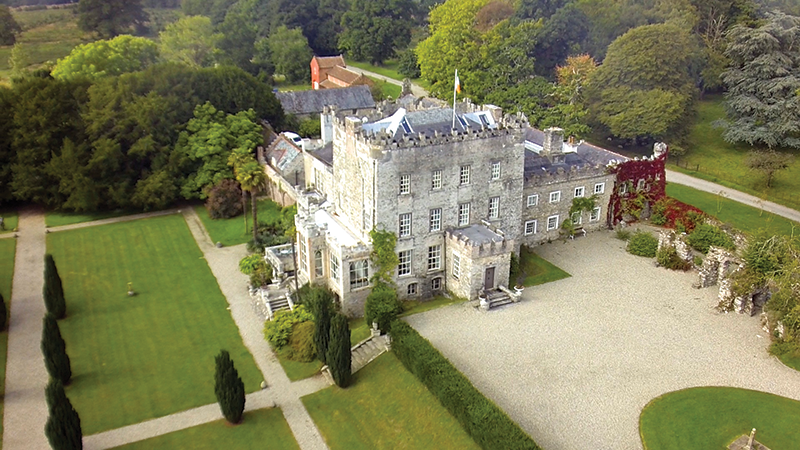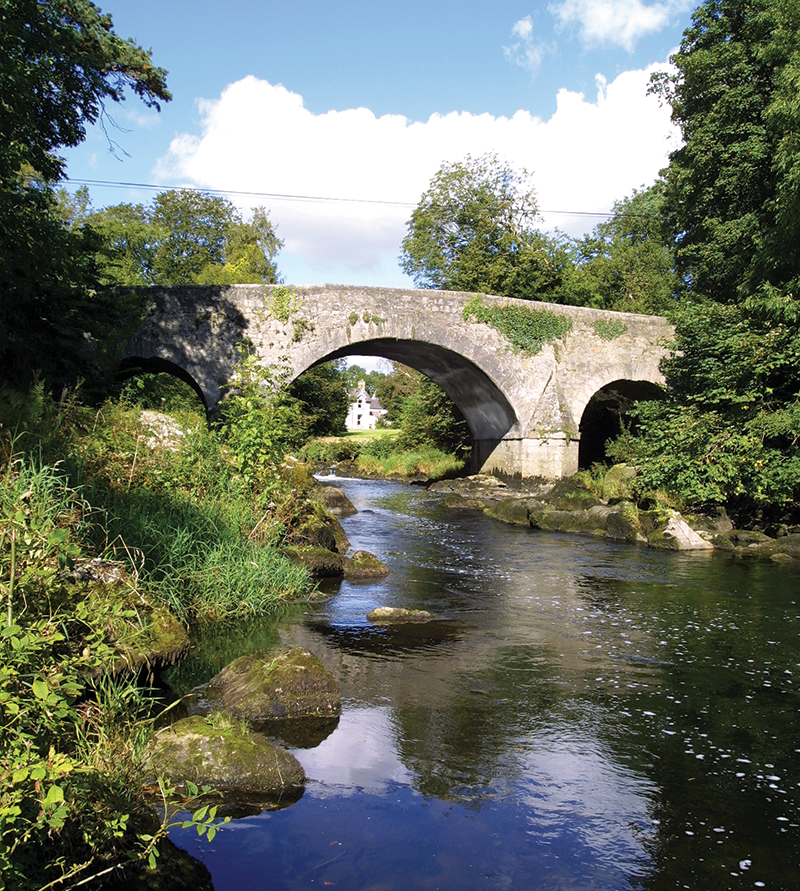- Provision of clean water
- Removal of pollutants from air and water
- Pollination provision
- Protection against soil erosion
- Rainwater retention
- Increased pest control
- Improvement of land quality
- Mitigation of land take and soil sealing
Heritage, Amenity and Landscape
The County Development Plan will seek to manage change by protecting important habitats, flora and fauna and by balancing the need for development with the preservation of important landscapes, amenity of places and features of heritage significance and natural beauty.

Heritage
Heritage plays an essential role in maintaining a high quality of life by way of promoting biodiversity, providing features of interest and contributing to the history, character and identity of areas. Heritage includes, buildings, rivers, trees, landscapes, archaeological sites together with their interrelationship with mankind. Some aspects of Carlow’s heritage are important in their own location and some are of national or international importance and contribute to the overall biodiversity of the wider region. Mechanisms for the protection of heritage features, landscapes and sites are provided through Planning and Development legislation together with Wildlife, National Monuments and Habitats legislation. The County Development Plan is an important medium that brings the various forms of heritage and landscape protection together.
Natural Heritage
Designated nature conservation sites located in County Carlow provide important habitats for flora and fauna and contribute to the overall biodiversity of the area. Designated natural habitats in County Carlow include the Special Areas of Conservation (SACs) comprising the Blackstairs Mountains, Slaney River Valley and River Barrow and River Nore. The basic designation for wildlife is the Natural Heritage Area (NHA). This is an area considered important for the habitats present or which holds species of plants and animals whose habitat needs protection. Within Carlow there are four Proposed Natural Heritage Areas, namely, Ardristan Fen, Ballymoon Esker, John’s Hill and Oakpark. Sites of geological interest have also been designated by the Geological Survey of Ireland. Preservation of these resources not only enriches quality of life and the identity of Carlow but also provides a unique selling point in terms of tourism and thus the local economy.
Built Heritage and Architectural Conservation
Architectural heritage is afforded protection through the Record of Protected Structures as contained in the County Development Plan which gives protected status to all structures that are deemed of special interest. Categories of special interest include architectural, historical, archaeological, artistic, cultural, scientific, technical and social interest. There are 546 structures on the County Development Plan list and 115 on the list of the Joint Spatial Plan for the Greater Carlow Graiguecullen Urban area. One overall list will be incorporated into the forthcoming County Development Plan at which time additions/deletions may be made in light of further survey work conducted.

Areas of the county which have a special character and architectural interest may also be protected through the designation of Architectural Conservation Areas (ACA’s). An ACA is a place, area or group of structures or townscape, whose character it is an objective of the development plan to preserve. Currently, there are ACAs contained within the Carlow Town Area and Borris village. An ACA provides a framework that will permit a degree of flexibility in terms of design consistent with the maintenance and improvement of the special character of the area.
Archaeological heritage is afforded protection through the National Monuments Acts. Currently there are c.950 recorded monuments within the county. Urban Archaeological Surveys have also been conducted for a number of settlements in the county. These surveys have identified areas containing a significant number of recorded monuments and therefore have the potential to contain more undiscovered sites. Areas within these settlements have been identified as Zones of Archaeological Potential.
Landscape
The landscape of County Carlow is characterised by four main character areas, namely the Central Lowlands, River Slaney – East Rolling Farm land, Blackstairs and Mount Leinster Uplands and the Killeshin Hills. The importance of these Character Areas, together with protected views and prospects and their ability to accommodate development has been assessed as part of the Landscape Character Assessment (LCA) contained within the existing Carlow County Development Plan 2015-2021. The LCA provides the basis for informed decision making and policy formulation and for the conservation and protection of the landscape. Carlow County Council recognises its responsibility to manage lands in the county on a sustainable basis. Sustainable land management requires an understanding of the nature and components of the landscape that create distinctive character and an understanding of the capacity of different landscapes to accommodate different forms of development. The County Development Plan will contain guidance together with policies and objectives that will seek to ensure that changes arising from developments will be sympathetic to the county’s landscape and provide a basis for landscape planning and management consistent with the principle of sustainable development.

Green Infrastructure
The term Green Infrastructure (GI) describes the interconnected networks of land and water all around us that sustain environmental quality and biodiversity and enrich quality of life. These areas include conservation areas, parks, open spaces, gardens, rivers, streams, floodplains, wetlands, woodlands, farmland and mountainous areas. The provision of green infrastructure contributes to environmental, economic and social benefits through natural solutions that support ecological processes thereby reducing dependence on “hard” infrastructure. As part of Project Ireland 2040, the importance of green infrastructure planning to inform the preparation of county development plans is recognised and supported. The County Development Plan will seek to address the importance of green infrastructure and recognise its multi-functional role performing several functions in a single shared space thereby enhancing opportunities for recreation and tourism, encouraging new business to invest and contributing to climate change adaptation.
Benefits Provided by Green Infrastructure
 ENVIRONMENTAL BENEFITS
ENVIRONMENTAL BENEFITS
 SOCIAL BENEFIT
SOCIAL BENEFIT
- Better health and human well-being
- Creation of jobs
- Diversification of local economy
- More attractive, greener cities
- Higher property values and local distinctiveness
- More integrated transport and energy solutions
- Enhanced tourism and recreation opportunities
 CLIMATE CHANGE ADAPTATION AND MITIGATION BENEFITS
CLIMATE CHANGE ADAPTATION AND MITIGATION BENEFITS
- Flood alleviation
- Strengthening ecosystems resilience
- Carbon storage and sequestration
- Mitigation of urban heat island effects
- Disaster prevention (storms, landslides)
 BIODIVERSITY BENEFITS
BIODIVERSITY BENEFITS
- Improved habitats for wildlife
- Provision of ecological corridors
- Landscape permeability
- Reducing habitat fragmentation
- Providing a buffer against climate change for habitats and species
QUESTIONS TO CONSIDER
- Are there any buildings, group of buildings, amenity areas, views that you consider to be of merit and should be afforded protection?
- How can change to the quality, character and amenity value of our landscapes be managed?
- Do you think high amenity areas should be designated in the County Development Plan? If so, what areas merit such designation?
- How can natural heritage and biodiversity be enhanced?
- How can greater access to natural, built and archaeological heritage be facilitated, while having regard to the sensitive nature of many sites?
- How can the Council best promote, support and increase awareness of the benefits of Green Infrastructure?
- What greening initiatives do you think should be considered for the county and incorporated into new development proposals?
